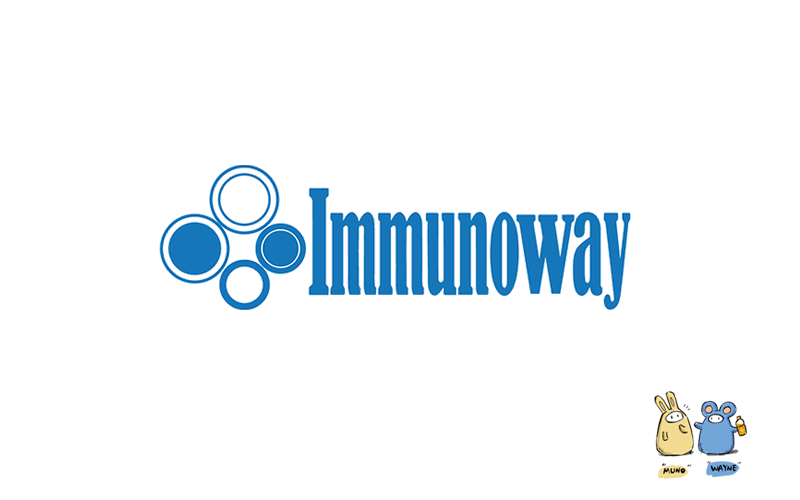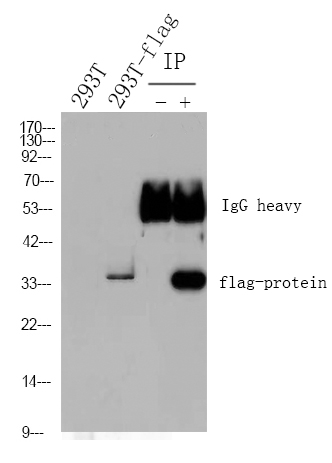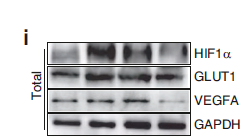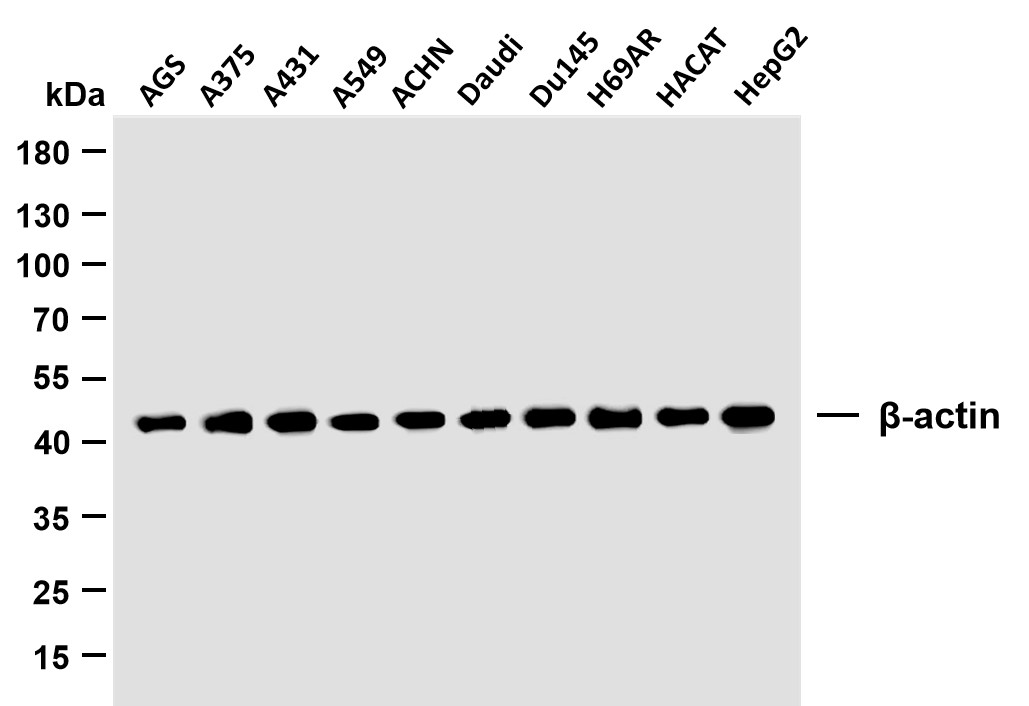
主要信息
Target
CAC1F
Host Species
Rabbit
Reactivity
Human, Mouse
Applications
WB, ELISA
MW
217kD (Observed)
Conjugate/Modification
Unmodified

货号: YN1525
规格
价格
货期
数量
200μL
¥3,780.00
现货
0
100μL
¥2,300.00
现货
0
40μL
¥960.00
现货
0
加入购物车


已收藏


收藏
详细信息
推荐稀释比
WB 1:500-2000; ELISA 1:5000-20000
组成
Liquid in PBS containing 50% glycerol, and 0.02% sodium azide.
特异性
CAC1F Polyclonal Antibody detects endogenous levels of protein.
纯化工艺
The antibody was affinity-purified from rabbit antiserum by affinity-chromatography using epitope-specific immunogen.
储存
-15°C to -25°C/1 year(Do not lower than -25°C)
浓度
1 mg/ml
实测条带
217kD
修饰
Unmodified
克隆性
Polyclonal
同种型
IgG
相关产品
抗原&靶点信息
免疫原:
Synthesized peptide derived from human protein . at AA range: 140-220
展开内容
特异性:
CAC1F Polyclonal Antibody detects endogenous levels of protein.
展开内容
基因名称:
CACNA1F CACNAF1
展开内容
蛋白名称:
Voltage-dependent L-type calcium channel subunit alpha-1F (Voltage-gated calcium channel subunit alpha Cav1.4)
展开内容
背景:
calcium voltage-gated channel subunit alpha1 F(CACNA1F) Homo sapiens This gene encodes a multipass transmembrane protein that functions as an alpha-1 subunit of the voltage-dependent calcium channel, which mediates the influx of calcium ions into the cell. The encoded protein forms a complex of alpha-1, alpha-2/delta, beta, and gamma subunits in a 1:1:1:1 ratio. Mutations in this gene can cause X-linked eye disorders, including congenital stationary night blindness type 2A, cone-rod dystropy, and Aland Island eye disease. Alternatively spliced transcript variants encoding multiple isoforms have been observed. [provided by RefSeq, Aug 2013],
展开内容
功能:
Disease:Defects in CACNA1F are the cause of Aaland island eye disease (AIED) [MIM:300600]; also called Forsius-Eriksson type ocular albinism. On the Aaland island in the Baltic Sea, AIED is an X-linked recessive retinal disease characterized by a combination of fundus hypopigmentation, decreased visual acuity due to foveal hypoplasia, nystagmus, astigmatism, protan color vision defect, myopia, and defective dark adaptation. Except for progression of axial myopia, the disease can be considered to be a stationary condition. Electroretinography reveals abnormalities in both photopic and scotopic functions.,Disease:Defects in CACNA1F are the cause of cone-rod dystrophy X-linked type 3 (CORDX3) [MIM:300476]. CORDs are inherited retinal dystrophies belonging to the group of pigmentary retinopathies. CORDs are characterized by retinal pigment deposits visible on fundus examination, predominantly in the macular region, and initial loss of cone photoreceptors followed by rod degeneration. This leads to decreased visual acuity and sensitivity in the central visual field, followed by loss of peripheral vision. Severe loss of vision occurs earlier than in retinitis pigmentosa.,Disease:Defects in CACNA1F are the cause of congenital stationary night blindness type 2A (CSNB2A) [MIM:300071]. Congenital stationary night blindness is a non-progressive retinal disorder characterized by impaired night vision.,Domain:Each of the four internal repeats contains five hydrophobic transmembrane segments (S1, S2, S3, S5, S6) and one positively charged transmembrane segment (S4). S4 segments probably represent the voltage-sensor and are characterized by a series of positively charged amino acids at every third position.,Function:Voltage-sensitive calcium channels (VSCC) mediate the entry of calcium ions into excitable cells and are also involved in a variety of calcium-dependent processes, including muscle contraction, hormone or neurotransmitter release, gene expression, cell motility, cell division and cell death. The isoform alpha-1F gives rise to L-type calcium currents. Long-lasting (L-type) calcium channels belong to the 'high-voltage activated' (HVA) group. They are blocked by dihydropyridines (DHP), phenylalkylamines, benzothiazepines, and by omega-agatoxin-IIIA (omega-Aga-IIIA). They are however insensitive to omega-conotoxin-GVIA (omega-CTx-GVIA) and omega-agatoxin-IVA (omega-Aga-IVA).,online information:Retina International's Scientific Newsletter,similarity:Belongs to the calcium channel alpha-1 subunit (TC 1.A.1.11) family.,subunit:Voltage-dependent calcium channels are multisubunit complexes, consisting of alpha-1, alpha-2, beta and delta subunits in a 1:1:1:1 ratio. The channel activity is directed by the pore-forming and voltage-sensitive alpha-1 subunit. In many cases, this subunit is sufficient to generate voltage-sensitive calcium channel activity. The auxiliary subunits beta and alpha-2/delta linked by a disulfide bridge regulate the channel activity. Interacts with CABP4.,tissue specificity:Expression in skeletal muscle and retina.,
展开内容
细胞定位:
Membrane; Multi-pass membrane protein.
展开内容
组织表达:
Expression in skeletal muscle and retina (PubMed:10873387). Isoform 4 is expressed in retina (PubMed:27226626).
展开内容
研究领域:
>>MAPK signaling pathway ;
>>Calcium signaling pathway ;
>>cGMP-PKG signaling pathway ;
>>cAMP signaling pathway ;
>>Cardiac muscle contraction ;
>>Adrenergic signaling in cardiomyocytes ;
>>Vascular smooth muscle contraction ;
>>Retrograde endocannabinoid signaling ;
>>Cholinergic synapse ;
>>Serotonergic synapse ;
>>GABAergic synapse ;
>>Insulin secretion ;
>>GnRH signaling pathway ;
>>Oxytocin signaling pathway ;
>>Renin secretion ;
>>Aldosterone synthesis and secretion ;
>>Cortisol synthesis and secretion ;
>>GnRH secretion ;
>>Cushing syndrome ;
>>Growth hormone synthesis, secretion and action ;
>>Alzheimer disease ;
>>Prion disease ;
>>Pathways of neurodegeneration - multiple diseases ;
>>Chemical carcinogenesis - receptor activation ;
>>Hypertrophic cardiomyopathy ;
>>Arrhythmogenic right ventricular cardiomyopathy ;
>>Dilated cardiomyopathy
>>Calcium signaling pathway ;
>>cGMP-PKG signaling pathway ;
>>cAMP signaling pathway ;
>>Cardiac muscle contraction ;
>>Adrenergic signaling in cardiomyocytes ;
>>Vascular smooth muscle contraction ;
>>Retrograde endocannabinoid signaling ;
>>Cholinergic synapse ;
>>Serotonergic synapse ;
>>GABAergic synapse ;
>>Insulin secretion ;
>>GnRH signaling pathway ;
>>Oxytocin signaling pathway ;
>>Renin secretion ;
>>Aldosterone synthesis and secretion ;
>>Cortisol synthesis and secretion ;
>>GnRH secretion ;
>>Cushing syndrome ;
>>Growth hormone synthesis, secretion and action ;
>>Alzheimer disease ;
>>Prion disease ;
>>Pathways of neurodegeneration - multiple diseases ;
>>Chemical carcinogenesis - receptor activation ;
>>Hypertrophic cardiomyopathy ;
>>Arrhythmogenic right ventricular cardiomyopathy ;
>>Dilated cardiomyopathy
展开内容
信号通路
Organismal Systems >> Endocrine system >> Insulin secretion
Organismal Systems >> Endocrine system >> GnRH signaling pathway
Organismal Systems >> Endocrine system >> Oxytocin signaling pathway
Organismal Systems >> Endocrine system >> Growth hormone synthesis, secretion and action
Organismal Systems >> Endocrine system >> Aldosterone synthesis and secretion
Organismal Systems >> Circulatory system >> Cardiac muscle contraction
Organismal Systems >> Circulatory system >> Adrenergic signaling in cardiomyocytes
Organismal Systems >> Circulatory system >> Vascular smooth muscle contraction
Organismal Systems >> Nervous system >> Cholinergic synapse
Human Diseases >> Neurodegenerative disease >> Alzheimer disease
Human Diseases >> Neurodegenerative disease >> Prion disease
Human Diseases >> Neurodegenerative disease >> Pathways of neurodegeneration - multiple diseases
Environmental Information Processing >> Signal transduction >> MAPK signaling pathway
Environmental Information Processing >> Signal transduction >> Calcium signaling pathway
Environmental Information Processing >> Signal transduction >> cAMP signaling pathway
Environmental Information Processing >> Signal transduction >> cGMP-PKG signaling pathway
文献引用({{totalcount}})
货号: YN1525
规格
价格
货期
数量
200μL
¥3,780.00
现货
0
100μL
¥2,300.00
现货
0
40μL
¥960.00
现货
0
加入购物车


已收藏


收藏
Recently Viewed Products
Clear allToggle night Mode
{{pinfoXq.title || ''}}
Catalog: {{pinfoXq.catalog || ''}}
Filter:
All
{{item.name}}
{{pinfo.title}}
-{{pinfo.catalog}}
主要信息
Target
{{pinfo.target}}
Reactivity
{{pinfo.react}}
Applications
{{pinfo.applicat}}
Conjugate/Modification
{{pinfo.coupling}}/{{pinfo.modific}}
MW (kDa)
{{pinfo.mwcalc}}
Host Species
{{pinfo.hostspec}}
Isotype
{{pinfo.isotype}}
产品 {{index}}/{{pcount}}
上一个产品
下一个产品
{{pvTitle}}
滚轮缩放图片
{{pvDescr}}



















